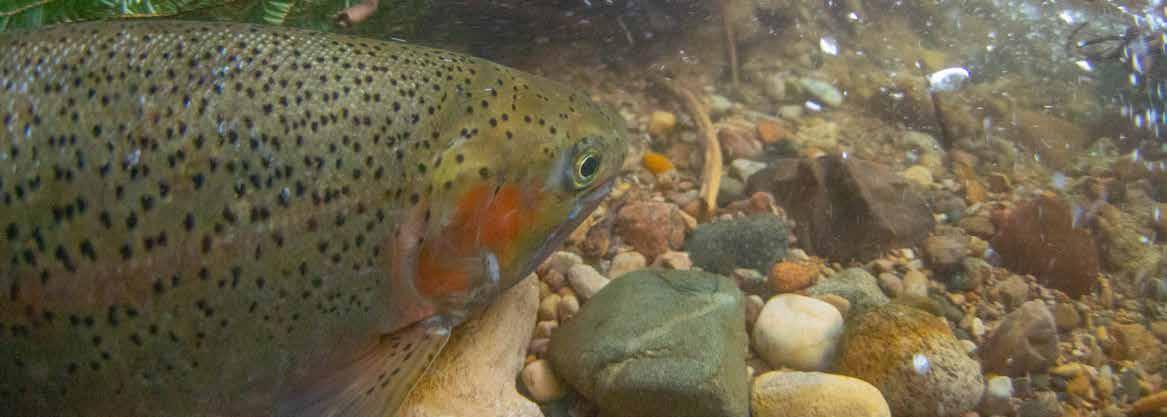Michigan Trout Unlimited
MICHIGAN Trout
The One Inch Minnows of Spring
22
by Kevin Feenstra, Feenstra Guide Service
Spring 2021
Recently I went fishing, and it was extremely cold. In these bitter conditions, I spend a lot of time fishing pretty large flies. Some of these flies imitate natural minnows, such as shiners or sculpins. Others are attractors that imitate nothing in particular and have so much flash that they look like they fell off a Christmas tree. (In fairness, I have tied flies out of things that fall off Christmas trees and Easter baskets). However, as we head toward spring, Michigan rivers will awaken with renewed life. Among this rebirth is a new generation of minnows. Imitating smaller minnows has a lot of advantages from an angler’s perspective. Although there are many ways to approach fishing in the spring, fishing small baitfish matches our hatches. This is one of the most versatile methods of fly fishing from late February until late May. Through much of the winter, our rivers lie dormant. Once the water temperatures drop into the mid to lower 30s, there is not a whole lot that changes from day to day. This is a real advantage for winter fishing; if you find a fly that is effective for steelhead or trout in late December, chances are, it will work until late February or early March. As soon as water temperatures begin to rise in the spring, you have to take a more fluid approach to the fishing as the preferences of both resident trout and migratory steelhead change. At some point each winter, we have some warmer days that translate into snowmelt. During the initial period of melt, there is runoff from the melting snow. This influx of water is very cold. In large rivers, it can cause water temperatures to drop a little. In smaller systems, snowmelt can make the water significantly colder. It might seem warm to you as an angler as you fish in the sunshine. However, for fishing purposes, you must still consider this to be winter fishing below the surface. Present your flies slow and deliberately during this time. This initial wave of cold water subsides, and eventually, water temperatures rise. During this warming period, fishing perks up and can reach great potential as water temps hit the upper 30s. As the river reaches the upper 30s, three things start happening that trigger activity in the fish and change their feeding preferences in rivers attached to the Great Lakes. Some steelhead, which have been in the river all fall and winter, spawn quickly when water temps rise a little. The smell of steelhead eggs immediately brings some resident trout onto the feed. At the same time, our first significant hatches occur—early brown and black stoneflies begin to migrate to the river’s edges and eventually crawl out of the river to hatch. These two events trigger some great fish
activity, and the third event is a real boom to the fishing from the perspective of one who loves to imitate baitfish. As we hit the upper 30s, salmon eggs laid in September and October hatch into fry. King salmon fry are most common, and they grow quickly to one or one-and-a-half inches. Salmon reproduce a tremendous amount of fry around the state of Michigan. Of all the minnows that I see, the fry of salmonids are among the most vulnerable. Often, they sit at the edge of the river, fairly high in the water column. This general lack of wariness makes them pretty easy targets for the trout and migratory fish. At the same time that these salmon fry are present, we have a resident family of minnows in our streams that activate as water temperatures rise. These small fish are called darters, and they are members of the perch family. Although they are starkly different in behavior from salmon fry, they are similar in size and appearance to a salmon fry. The net result is that many of our rivers are suddenly full of a couple of families of small minnows. Though only distantly related, these minnows can be imitated simultaneously with generic flies. Though water temperatures have risen, it is still pretty cold water late in the winter and early spring. As the water hovers in the upper 30s, the fly needs to be presented close to the bottom to draw the attention of any large predatory fish. Cold water by itself will make game fish inconsistent in their feeding patterns. Furthermore, as salmon fry pop from the gravel and join the native minnows, they are a small target at one inch long. A large fish simply won’t burn very much energy to catch a small minnow. Presenting to late winter fish offers some versatility, and you can use a couple of methods. One great way to catch fish with small minnow patterns is to fish them as though they are nymphs. You can float them under an indicator or bounce them along the bottom. Unlike nymphing with traditional nymphs and eggs, it is less essential that the fly be presented in a straight line. Game fish are expecting minnows to swim irregularly. Therefore, always allow your minnow pattern, which you are fishing as a nymph, to swing at the end of the drift. As the fly breaks free from the bottom, it may draw the ire of a steelhead or trout looking for a vulnerable meal. While indicator nymphing with minnows, you can fish them with traditional split shot methods. However, one great alternative is to weight the minnow with a tungsten bead or barbell eyes. This will cause it to be the weight of the system











